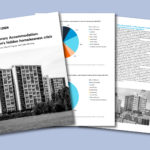More than 75,000 children are stuck in temporary accommodation due to insufficient housebuilding and low benefits, Centre for London report finds.
Local authorities in London face the largest demand for temporary accommodation nationwide, with 59% of England’s households in temporary accommodation residing in the city. This represents 56,500 households, including 75,580 children.
Although temporary accommodation is only intended as a short-term solution while residents wait for a permanent home, many households are trapped in cramped homes far from their work or school as London’s lack of affordable housing stock strains the system. 82% of all England’s out-of-borough temporary accommodation placements are in London. Of these, 7% of placements moved the households outside of London, often separating families from vital social connections.
These findings are published in “Temporary Accommodation: London’s hidden homelessness crisis”, a Centre for London report that calls for all levels of government to focus on fixing London’s broken temporary accommodation system.
The capital’s higher cost of living is the driving force behind London’s high demand for temporary accommodation. Warning of a surge in the number of Londoners at risk of homelessness this winter due to the cost-of-living crisis and rising rents, the report makes recommendations aimed at alleviating the pressures councils face to provide suitable short-term housing for those in need.
The issue is impossible to separate from the wider housebuilding crisis, and the majority of the report’s recommendations are directed at national government, as only they have the power to make real change. The report says the Government should:
- Increase homelessness-prevention grants available to local authorities to help them assist those at risk of homelessness due to the cost-of-living crisis.
- Set up a cross-departmental working group tasked with solving supply issues of temporary accommodation and identify their cost to the public purse.
- Build more “general needs” affordable homes to ease overall supply issues, while also working with the Mayor of London to subsidise councils to increase their own supply of temporary accommodation.
The report also recommends that benefits should be increased to support people at risk of homelessness via the welfare system. People often become homeless because they don’t earn enough to pay their rent, so the report calls for two main changes that would help in tackling the scale of the issue: raising or removing the £23,000 benefit cap and matching Local Housing Allowance rates to match the real cost of housing in London.
Low supply and insufficient benefits mean local authorities struggle to secure temporary accommodation for everyone who needs it. The report identifies variation in the housing type, quality and distance from where a household previously resided that homeless Londoners are offered as a result. The report found that while the likelihood of the worst-case scenario of being placed in ‘bed & breakfast’ accommodation — typically involving an entire household living in one room with shared kitchen and bathroom facilities — has declined in recent years, the cost-of-living crisis may make this worse. Similarly, out-of-borough placements, where a household must move from their area to live in accommodation elsewhere, have fluctuated in recent years, but are at risk of rising again.
In order to respond to these issues, the report also outlines a code of good practice for London’s local authorities to follow when providing temporary accommodation, including that families with children should not be allocated nightly paid accommodation without a kitchen, and that travel times to and from new accommodation should be calculated based on available bus routes or walking, as homeless families are unlikely to afford trains or a car.
Claire Harding, Research Director at Centre for London said: “Far too many Londoners are already stuck in temporary accommodation and we’re really worried that the number will rise this winter.
But it doesn’t need to be this way: the Everyone In programme, which addressed rough sleeping during the pandemic, shows what can happen when government puts money and focus into tackling homelessness. We can do the same for the children and families in London who use temporary accommodation.”
Joanne Drew, Co-Chair of the London Housing Directors’ Group, commented: “London faces the most severe homelessness crisis in the country. Everyone deserves the security of a permanent home, but massive numbers of homeless Londoners live in temporary accommodation, with increased long-term occupancy of commercial hotels because other options aren’t available. The pressures on homeless families are immense and boroughs have long warned that the situation is unsustainable.
“In recent years we’ve seen good progress made in tackling rough sleeping in the capital thanks to effective partnership work with the government and the injection of extra resources. A similar approach must be taken to London’s temporary accommodation challenges, and boroughs look forward to working with ministers on this crucial agenda.”
Tom Hill, Executive Director, The Hill Group, said: “Since 2019 Hill has been designing and commissioning SoloHaus, a modular home that has been making a tangible difference to vulnerable people across the country by providing safe, secure and energy-efficient accommodation. Our SoloHaus homes cannot solve the homelessness crisis but they make an important addition to a council’s range of solutions. We have further developed the product this year, adding DuoHaus and now FamilyHaus to the collection. These modular homes are quick to build and install, offering a fast and efficient solution to help many people off the streets and into secure housing.”
You can download a copy of the report here.









